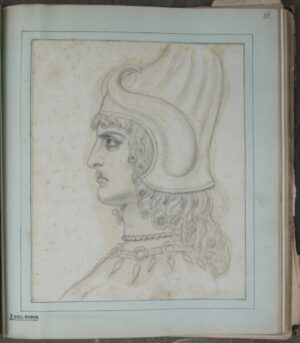Paton, Sir Joseph Noel (1821-1901)
Paton was a Scottish artist, illustrator and sculptor. He was also a poet and had a deep seated interest in, and knowledge of, Scottish folklore and Celtic legends.
He was born in Wooer's Alley, Dunfermline, Fife, on 13 December 1821 to Joseph Neil Paton and Catherine MacDiarmid, damask designers and weavers in the town. He is the brother of the sculptor Amelia Robertson Hill and the landscape artist Waller Hugh Paton. He also had one brother, Archibald, and two sisters, Catherine and Alexia, who all died in childhood; Paton erected a monument on the grave of his parents and dead siblings in later life, the grave was probably originally unmarked. It lies on the north side of Dunfermline Abbey and is a distinctive red granite Celtic cross amongst other smaller sandstone markers.
Paton attended Dunfermline School and then Dunfermline Art Academy, further enhancing the talents he had developed as a child. He followed the family trade by working as the design department director in a muslin factory for three years. Most of his life was spent in Scotland but he studied briefly at the Royal Academy, London in 1843, where he was tutored by George Jones. While studying in London Paton met John Everett Millais, who asked him to join the Pre-Raphaelite Brotherhood.
In 1858, he married Margaret Gourlay Ferrier and the couple had eleven children (seven sons and four daughters). Their eldest son, Diarmid Noel Paton (1859–1928), became a regius professor of physiology in Glasgow during 1906 while another son, Frederick Noel Paton (1861–1914), was appointed as director of commercial intelligence to the government of India in 1905 but was also a noted illustrator.
The invitation to be an official member of the Brotherhood was turned down by Paton although he painted in the Pre-Raphaelite style and became a painter of historical, fairy, allegorical and religious subjects. Together with Daniel Maclise, Paton was a folklore expert; according to Christopher Wood, an expert in Victorian art, Maclise and Paton were the only artists working in the genre of fairy paintings with expertise in folklore. Paton's knowledge of Celtic legends and Scottish folklore is reflected in his paintings. During his short spell in London, Paton became acquainted with Samuel Carter Hall, editor of The Art Journal, and he commissioned Paton to design some of the illustrations for his 1842 book The Book of British Ballads. Other commissions to design book illustrations included the 1844 edition of Shelley's lyrical drama Prometheus Unbound, an 1845 publication of Shakespeare's The Tempest and an 1863 version of Coleridge's poem The Rime of the Ancient Mariner.
In 1844 Paton's first painting, Ruth Gleaning, was exhibited at the Royal Scottish Academy. He won a number of prizes for his work including for two of his most famous works The Quarrel of Oberon and Titania and The Reconciliation of Oberon and Titania (1847 – Westminster Hall), both of which are available to public view at the National Gallery of Scotland. An earlier study of the Quarrel painting was completed in 1846 and featured as Paton's diploma picture at the Royal Scottish Academy that year. The Academy purchased the earlier work for £700.
Made an associate of the Royal Scottish Academy in 1847 and a fellow in 1850. In 1865, he was appointed Queen's Limner for Scotland. He also published two volumes of poetry and produced a number of sculptures. Two years later he received the knighthood and in 1878 was conferred the degree LL. D. by the University of Edinburgh.
Paton was a well known antiquary, whose specialty was arms and armour. He died in Edinburgh on 26 December 1901, and is buried in Dean Cemetery (in the obscured lower terrace to the south). His daughter, Hamilton Lora (1868-1921), is buried 10m to his east with her husband, Robert Scott Moncrieff (1862-1923).
Wikipedia.
Showing the single result
